13 Types of Pricing Strategies (Higher Revenue + Profits)
Pricing is a crucial phase in marketing your products or services that portrays the value of your offer. As much as it can skyrocket your profit margins, it can make your business suffer a great financial loss.
In order to generate huge revenue in sales, you need to develop the appropriate pricing strategy, which is where you might run into trouble. If you underprice your products, you tend to miss out on profitability, over-price your offers, and your potential clients are a mile away.
So, how do you set the right price for your offer? All you need is a pricing strategy that positions you ahead of the curve.
This article explores the 13 proven pricing strategies that will help you set the best prices and meet your business goals.
Let’s dive in.
What are Pricing Strategies?
Pricing strategies are the different means and methods employed by a business entity to determine the cost of its goods and services.
These strategies focus on helping you set prices that strike a balance between value and cost, such that your business profits without hampering customer’s expectations.
Different pricing strategies serve different purposes for a business. While some pricing strategies help gain market share, others help improve the business's profit margins. Some use pricing to publicize their offerings towards building a new and strong customer base.
Whatever pricing strategy a business employs, it needs to conform with the already laid down goals of the business.
Smart businesses examine their business objectives, target audience, brand positioning, production cost, and trade margins before setting up a price. They also consider external factors like the competitor’s pricing, government policies, consumer demand, and market trends.

When choosing your pricing strategy, it is important to fashion out a method tailored to your purpose and acceptable to your target audience. A pricing strategy that works for a product-based business may not work for a service-based business.
By setting the right prices, you boost sales, stay ahead of competitors, and ensure the long-term sustainability of your business.
The best part is that you can adopt more than one pricing strategy, especially if you offer multiple products or services. You can market a product using different pricing strategies, depending on your target customers.
Types of Pricing Strategies
One of business owners' biggest challenges is determining the appropriate price for their goods or services. Pricing is a key criterion of every business set-up, and choosing the right strategy can impact your business positively.
Here are 13 different types of pricing strategies with their pros and cons highlighted alongside.
1. Penetration Pricing
Penetration pricing is a planned pricing strategy whereby the prices of a product are initially set low to quickly reach a wide range of audience. This strategy helps new businesses enter into a new market and have a chance of capturing some market share.
The trick behind this pricing method is to use low prices to raise awareness about a new product and steal a competitor’s market audience. After some time, the company raises the price to recover and maximize profits and demonstrate the increasing value of the product.
One fact you will agree with is that the penetration strategy works well with top-notch branding, even though it is usually employed in the short term. When used in the long term, it becomes unsustainable, and the business can begin to leave too much money on the table.
The penetration pricing strategy has a huge effect on sales, helping new businesses guarantee a boost in their initial sales. You enjoy much of the revenue that would have been diverted to other competitors.
If you are considering how to make instant sales in your business, then the penetration pricing strategy is one for you to consider. This pricing strategy is perfect for product-based and service-based businesses.
Examples of Penetration Pricing
Product-Based Companies
Many product-based manufacturers, like food and beverage companies, often leverage this method to introduce new products into the market. They set low prices so customers can give them a try and patronize them.
In product-based penetration pricing, different companies make use of a unique approach to achieve their aim. For example, a new drink company is trying to enter the fizzy drink industry. By first slashing their price by 20%, they gain recognition in the market and consumer demand.
After acquiring a large chunk of customer interest, the company can increase to a higher price to compete with other fizzy drink-producing companies.
While a fizzy drink company uses this approach, a sausage company may decide to employ a buy-two-get-one-free approach. The common goal of both companies is to promote their products and have a good bottom line.
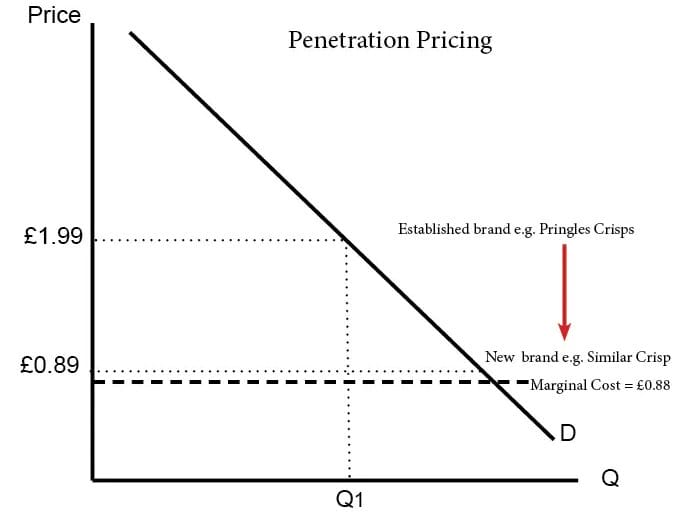
The graph above is a typical example that shows the penetration strategy of a new brand against an established brand. The established brand is a pringle crisp that sells at £1.99, having a good profit margin compared to that of the new brand using £0.89.
Calculating the marginal cost between both brands, the new brand sacrifices £0.88 to divert some market share and attention to its own end.
Service-Based Companies
Proper examples of service-based companies are the Internet and cable providers like Netflix, Amazon Prime, and telecommunication companies.
Most of the providers offer free streaming services (free trials or extra channels) to draw in new subscribers. Although there is usually an ultimatum, offers like these are still strongly effective.
Other approaches employed by service-based companies are bonuses and the choice of subscription plans. With these incentives, companies are able to stand out in the midst of competition.
Pros
- Raises brand awareness.
- Helps win customers from competitors.
- Limits competition as your price is the bargain in the market.
- Helps you capture a significant amount of the market share.
Cons
- Requires significant up-front investment.
- A relatively high risk as there is no ready guarantee of success.
- Leads to a price war with stronger competitors.
- Not a suitable long-term pricing strategy.
2. Skimming Pricing
Skimming pricing involves charging customers different prices according to different segments. The goal of this pricing strategy is to maximize profits early on as the fall in the price of the specific good or service is imminent.
This pricing strategy involves setting a higher-than-normal price on your product or service immediately after it hits the market. After a justifiable period, you drop the initial price to a lower and compatible price, implying the product has reached the end of its life cycle.
You will find the skimming pricing strategy in the high-tech industry among gadget, software, and application manufacturers.
The rationale behind this strategy is that a company comes out with a completely new offering and charges a premium for it. With time, the product loses the buzz, and the price is slashed considerably as the market demand falls.
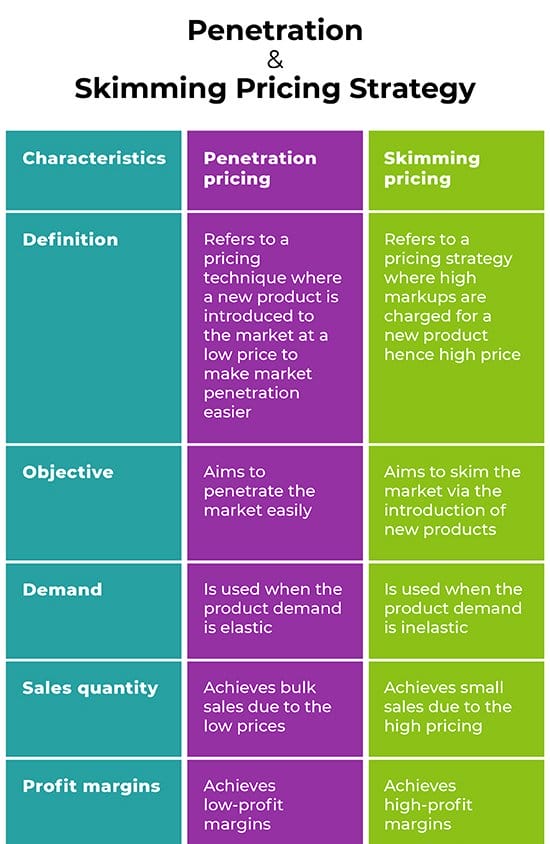
A practical example is when Apple comes up with a new phone in the iPhone series and puts up a hefty price for its new specifications.
The market responds and buys this new product at a high price due to the demand and buzz around it. After a while, the price is reduced as the product becomes more popular and available in the market.
Pros
- Provides higher upfront sales figures to cover production costs.
- Helps to create a high-end brand image for a business
- Encourages free organic word-of-mouth advertising about your product.
Cons
- Limited by other competitors offering similar products.
- Only work with demand that does not respond to price changes.
- Requires a degree of monopoly power.
3. High-Low Pricing
High-low pricing is a type of pricing strategy similar in ideology to the skimming pricing strategy. In this type of pricing strategy, a company initially charges a high price for its product and service and brings it down to a lower price later on.
Unlike the price-skimming strategy, the slash in pricing is not direct but comes in the form of promotions, markdowns, and clearance sales.
The main goal of the high-low pricing strategy is to alternate the price of a good or service between high and low over a specific period. By leveraging price-sensitive customers, this strategy comes out as an effective bargain, driving high sales during the period.
Note that the changes in prices in this pricing strategy are not permanent, which is what distinguishes it from the skimming pricing strategy. Over time, the company returns the price of the good or service to the initial price before the change after the elapse of the allocated time.
An example of this pricing strategy is in the case of seasonal products, where the price is high during its in-demand season. During the off-season, when the product is no longer in demand, the business can slash prices through clearance sales to boost demand.
Pros
- An effective strategy for selling off low-demand products.
- Helps increase the revenue of a business.
Cons
- The business is open to losing profits as customers can exploit the vulnerability of the change in prices in their favor.
4. Premium Pricing
The premium pricing strategy is one of the common pricing strategies employed by brands to leverage their high-quality products. This pricing strategy involves pricing your product higher than those of your competitors to signify luxury or quality.
Similar to skimming pricing, the premium pricing strategy aims to create a perception that your product offers more in quality. The premium price attached to your product helps create this impression and works best when employed with an effective marketing strategy.
Unlike the skimming pricing strategy, the premium pricing strategy sets a high price and maintains the price.
For this pricing strategy to work, your brand must have a positive brand perception, making it easy for customers to accept the price. Having a loyal customer base is one of the criteria that guarantees the success of this pricing strategy.
The beauty and luxurious industry are known for using this pricing strategy. For example, the luxurious car-making brand Rolls Royce offers a wide range of luxurious cars at prices higher than its competitors.
Pros
- Guarantees higher profit margins.
- Helps improve a brand’s perception and value.
Cons
- Shortcomings occur when the market does not consider your product to be a premium.
- Low sales volume.
5. Freemium Pricing
The freemium strategy offers customers free access to a specific product for a fixed amount of time. Everybody gets excited when they get gifts. This pricing strategy uses gifts to gain acceptance in the market.
Tech and software companies are the businesses associated with this pricing model as their business structure allows it. They provide customers access to a basic version of a product at no charge, with the option to pay for access to advanced features.
The goal of the freemium pricing strategy is to convert customers enjoying free access to premium users. Customers get a taste of what they want before subscribing, which is a win-win situation for both parties.
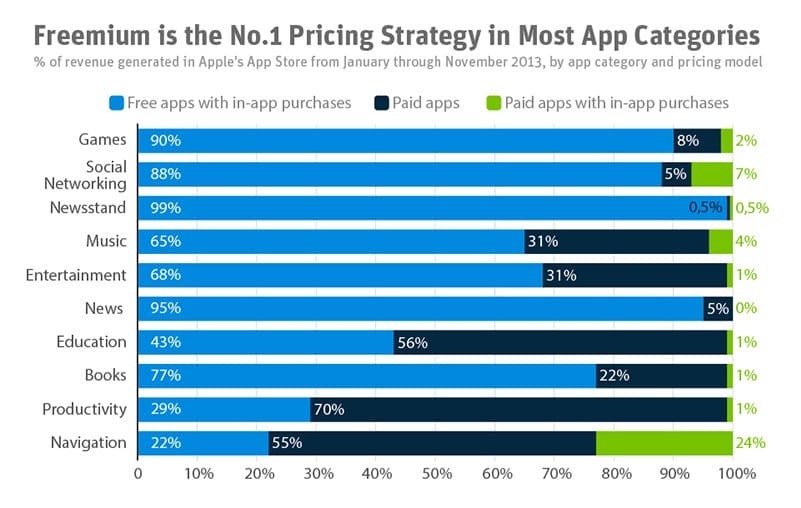
Pros
- Helps businesses create brand awareness.
- Converts free customers to paying ones.
- Helps businesses establish a universal appeal that brings in new customers.
Cons
- There is always the risk of users not going premium.
6. Psychological Pricing
The psychological pricing strategy is one of the common pricing strategies employed by businesses to attract customers.
Unlike other pricing strategies, the psychological pricing strategy relies on mental and emotional methods to influence the decisions and behavior of the market.
The rationale behind this pricing strategy is to set prices that appear lower than the value offered to customers. Customers are pushed to purchase more of the product than they would normally due to the perception that they are getting more in value.
Psychological pricing strategies come in different forms, majorly as charm pricing or artificial time constraints.
A practical example of charm pricing is the use of the $.99 value to convince customers that they are getting a product at a bargain. This strategy is the more common type of psychological pricing. You will find this strategy actively in use by retail and restaurant businesses.
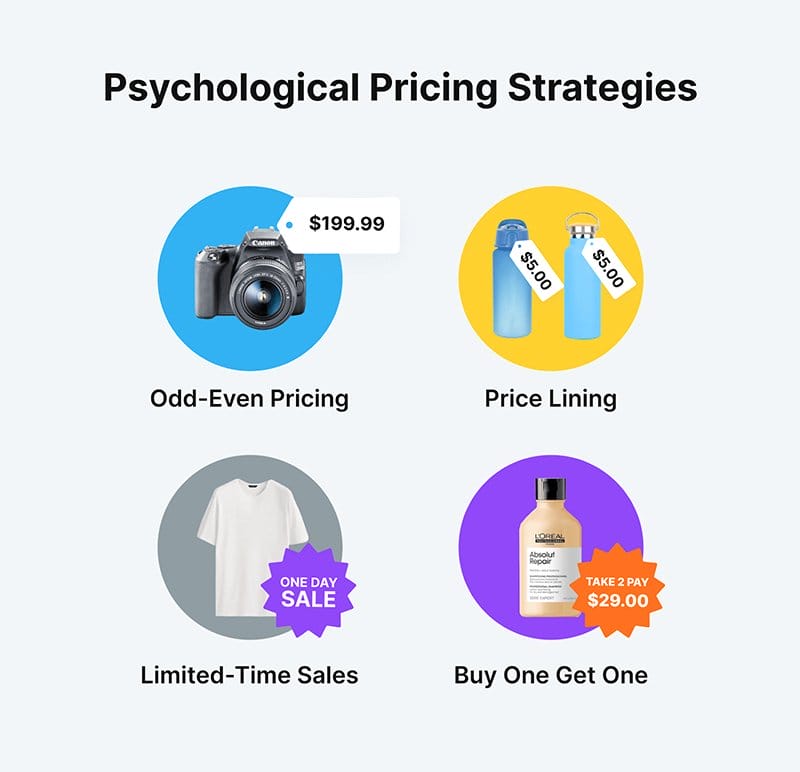
Pros
- Simplifies business decisions.
- Helps increase overall sales.
- Gives businesses a competitive advantage in a competitive market.
Cons
- Loses its effectiveness in global markets.
- Businesses are at the risk of losing the trust of their customers when they employ this pricing strategy.
7. Bundle Pricing
Bundle pricing is a pricing strategy that benefits both parties, as buyers and sellers both get a return from their transactions. In this type of pricing strategy, the seller offers the market combined products and services usually at a discounted price.
The idea behind bundle pricing is that rather than customers buying a single item, they buy different items at a reduced price. Over time, the business makes more money as people purchase more goods and services irrespective of the fact that it is at a discounted price.
An example of a bundle pricing strategy used effectively is in meal deals offered by fast food restaurants. Rather than selling individual products, these businesses offer customers a combo at a discount price, mixing its popular products with the not-so-popular ones.
Other than fast food businesses, beauty salons and online stores are examples of businesses that use this pricing strategy as their marketing strategy.
Pros
- Helps businesses clear excess stocks.
- Reduce marketing costs.
- Increases customer spending.
Cons
- Potentially decrease customer satisfaction.
8. Competitive Pricing
The competitive pricing strategy requires you to conduct significant research about the market. Unlike other pricing strategies, the competitive pricing strategy depends on the market price of the good or service you plan to introduce.
By implementing the competitive pricing strategy, you gain insights into the market, recognizing who your competitors are. The main aim of the competitive pricing strategy is to keep you competitive even in the face of stern competition.
In order to attract and sustain the interest of audiences, it is important to understand competitors’ pricing structure and how consumers perceive their value.
Setting your prices equally or slightly lower than competitors’ prices is a deciding factor for customers' purchases.
Let’s assume that you own a shipping agency, and competitors offer shipments between $1 – $1.5 per kilogram. The benchmark of your shipping fee per kilogram should fall between both prices or slightly less in order to enjoy a great competitive advantage.
You can find a practical example of a competitive pricing strategy in the automobile industry. A new manufacturer conducts his due diligence and pegs his price at the average price of other automobiles with similar properties.
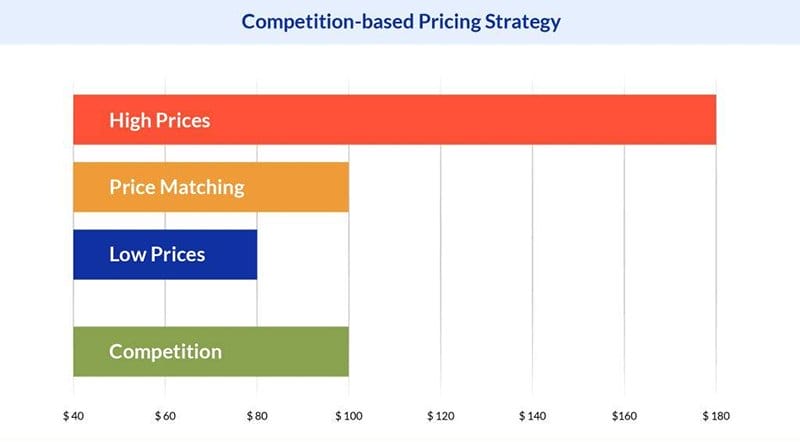
Pros
- Cost-effective.
- There is low risk associated with it.
- Easy to use.
- Allows for dynamic pricing strategy.
Cons
- Not customer-centric.
- You risk losing potential profits from pegging your price within the market range.
9. Cost-Plus Pricing
A cost-plus pricing strategy is a calculative type of pricing strategy requiring you to take into account your production cost. Another name for the cost-plus pricing strategy is the markup pricing strategy.
In this type of pricing strategy, you set the price of your goods as a percentage increase after adding labor and production costs. This strategy aims to ensure that you cover your manufacturing costs and earn a consistent profit margin.
A cost-plus pricing thrives in products-based businesses (buying and selling) but may not find expression in service-based business due to variance in services offered.
However, it does not take into account the customer’s perceived value, competitors' prices or external factors before setting the price. This strategy may not be suitable for products with high differentiation or strong competition.
The mathematical representation of the cost-plus pricing model is:
Cost-Plus Pricing = Cost + Desired Markup Percentage
OR
Cost-Plus Pricing = Labor Costs + Material Costs + Overhead Costs x (1 + Markup Amount)
- Labor cost (LC) refers to the amount of money you pay to workers for their work.
- Material cost (MC) refers to the total money spent on materials to produce a product.
- Overhead cost (OC), in simple terms, is unbudgeted expense. This cost is an ongoing business expense that is not directly attributed to creating a product or service.
Let’s assume that the LC of a shoe is $20, MC is $10, and OC is $5, respectively, taking the desired markup percentage to be 40%. Let’s calculate the selling price of each shirt.
Cost-Plus Pricing = Labor Costs + Material Costs + Overhead Costs x (1 + Markup Amount)
Cost-Plus Pricing = $20 + $10 +$5 * (1 + 40%)
Cost-Plus Pricing = $35 * (1 + 0.4)
Cost-Plus Pricing = $35 * (1.4)
Therefore, the selling price of a shoe is $49.
Pros
- Easy to calculate.
- Easier to predict the profit margin.
Cons
- May not reflect the true value of the product.
10. Dynamic Pricing
Dynamic pricing, otherwise known as demand pricing, is designed to ensure the price matches the current market demand.
One of the common price strategies examples, the dynamic pricing strategy uses surge and time-based costing to arrive at a standard price.
This pricing model requires businesses to assess current market requirements and set an adaptable price. A form of price discrimination, the dynamic pricing strategy ensures the business maximizes profits, which is the sole aim of every business.
Dynamic pricing is standard practice in the transportation, entertainment, shopping, leisure, and hospitality industries. In these examples, the price of their goods and services fluctuates on a time-bound basis, hence the need for a dynamic pricing strategy.
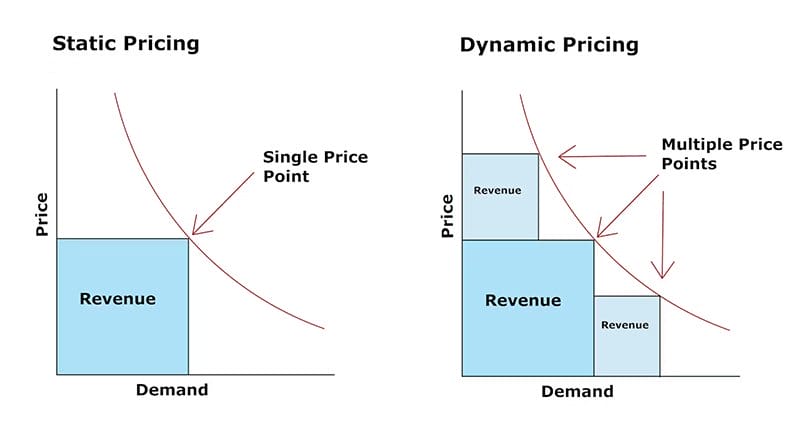
Pros
- Better market overview.
- Increases revenue.
- Gives companies more control over their pricing strategy.
Cons
- There is a risk of losing customers.
- There is a risk of starting a price war.
11. Economy Pricing
The economy pricing strategy involves shifting a large number of specific products being sold for a lower price. Of the different types of pricing strategies, the economy pricing strategy stands out with its emphasis on low product production cost.
The rationale behind this pricing strategy is to cut out competitors and make significant profits through large-volume sales. With this strategy, you are guaranteed a healthy cash flow as price-conscious customers pull up their numbers.
Economy pricing is a pricing strategy common in the commodity goods sector and among generic brand items. These businesses do not have to spend money recouping before generating profit.
Pros
- Effective when targeting specific demographics.
- Provides businesses with a fast way to acquire new customers.
Cons
- The profit margins are usually tight and constrained.
12. Loss-Leader Pricing
The loss-leader pricing involves lowering the price of an item to increase sales of others. One of the effective value-based pricing strategy examples, the loss-leader pricing strategy, works on complementary goods that depend on each other.
In this strategy, there are two categories of goods, the leader, which gets the significant price drop, and the complementary goods.
By lowering or receiving a loss on the leader product, the businesses then make up for the loss by increasing the price of other complementary products.
A practical example of this pricing strategy is in the gaming industry, where businesses reduce the cost of gaming consoles. Other complimentary products like video games and other accessories are then spiked to make up for the loss from the leader product.
Pros
- Effective for selling excess inventory.
- Effective for tracking advertising.
- Helps attract new customers
Cons
- Lowers the perception of a brand.
- There is always a risk of making a loss if customers do not buy the complementary products.
13. Value-Based Pricing
The value-based pricing strategy refers to setting a price based on the customer’s perceived value of your product or service. This pricing strategy is primarily influenced by customers with respect to value and how much they are willing to pay.
Many a time, businesses set their prices to revolve around the cost of production, competitors’ pricing, and preferred profit margins which is quite strategic. However, they miss out on the opportunities that come with a value-based strategy.
A value-based pricing strategy focuses on offering value to your customers. With the appropriate use of this pricing strategy, businesses can command the loyalty of customers even in the midst of competition.
This strategy changes the perception of businesses towards customers' purchases. Specifically, it shows that target audiences can buy a product irrespective of the cost as much as they get an unmatched value for the price.
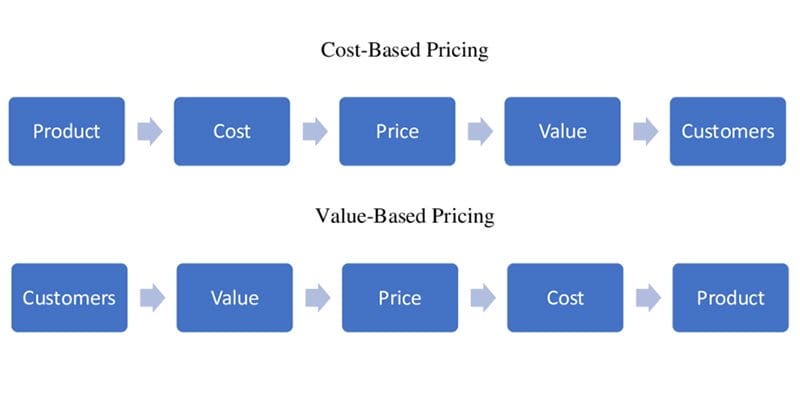
The value-based pricing models work best with products or services that exist in controlled environments or are associated with emotional components.
An industry that leverages value-based pricing is the technology industry. Take Apple, for example. Most content creators and graphics designers prefer an Apple iPhone because of its unique features like sharp cameras, operating systems, and branding.
Based on this demand, Apple can effortlessly rely on value-based pricing and maximize profits on a high scale.
If your product solves a problem, provides a unique benefit, or creates an emotional connection, you can charge accordingly, and customers will buy without hesitation.
Pros
- Promotes customer loyalty.
- Accounts for added value.
- Commands higher price points.
- Allows for easy market penetration.
Cons
- There can be difficulty in sustaining perceived value.
- Difficulty in scaling your business.
- Requires ample time for research.
Choose a Pricing Strategy to Reach Your Business Goals
Finding the best pricing strategy does not have to be a trial-and-error exercise. Several factors help you determine the best pricing strategies that will positively impact your business.
In choosing an effective pricing strategy, first, determine your business goals and objectives. Without this information in place, you can’t choose an effective pricing strategy that works for you.
- If your business goal is to enter a new market and capture market share, use the penetration pricing strategy.
- If you want to maximize profits for new products, use the skimming pricing strategy.
- If you want to clear your inventory of out-of-date products or sell seasonal products at a good profit margin, use the high-low pricing strategy.
- If you sell an innovative or high-value product and want to maximize your profits, use the premium pricing strategy.
- If you want to maximize the number of products or services customers buy from your business, use the bundle pricing strategy.
- If your business goal is to build brand awareness and grow your customer base, use the freemium pricing strategy.
Explore Further
- What is Marketing Mix (4Ps, 7Ps, 4Cs, 7Cs)?
- Types of Business Strategies
- Types of Business Structures
- What is a Business Level Strategy?
- Business Strategy Templates
- Strategic Plan Templates
- How to Grow a Small Business
- How to Start a Business With No Money